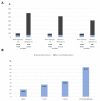Diplopia Is Frequent and Associated with Motor and Non-Motor Severity in Parkinson's Disease: Results from the COPPADIS Cohort at 2-Year Follow-Up
- PMID: 34943619
- PMCID: PMC8700703
- DOI: 10.3390/diagnostics11122380
Diplopia Is Frequent and Associated with Motor and Non-Motor Severity in Parkinson's Disease: Results from the COPPADIS Cohort at 2-Year Follow-Up
Abstract
Background and objective: Diplopia is relatively common in Parkinson's disease (PD) but is still understudied. Our aim was to analyze the frequency of diplopia in PD patients from a multicenter Spanish cohort, to compare the frequency with a control group, and to identify factors associated with it.
Patients and methods: PD patients who were recruited from January 2016 to November 2017 (baseline visit; V0) and evaluated again at a 2-year ± 30 days follow-up (V2) from 35 centers of Spain from the COPPADIS cohort were included in this longitudinal prospective study. The patients and controls were classified as "with diplopia" or "without diplopia" according to item 15 of the Non-Motor Symptoms Scale (NMSS) at V0, V1 (1-year ± 15 days), and V2 for the patients and at V0 and V2 for the controls.
Results: The frequency of diplopia in the PD patients was 13.6% (94/691) at V0 (1.9% in controls [4/206]; p < 0.0001), 14.2% (86/604) at V1, and 17.1% (86/502) at V2 (0.8% in controls [1/124]; p < 0.0001), with a period prevalence of 24.9% (120/481). Visual hallucinations at any visit from V0 to V2 (OR = 2.264; 95%CI, 1.269-4.039; p = 0.006), a higher score on the NMSS at V0 (OR = 1.009; 95%CI, 1.012-1.024; p = 0.015), and a greater increase from V0 to V2 on the Unified Parkinson's Disease Rating Scale-III (OR = 1.039; 95%CI, 1.023-1.083; p < 0.0001) and Neuropsychiatric Inventory (OR = 1.028; 95%CI, 1.001-1.057; p = 0.049) scores were independent factors associated with diplopia (R2 = 0.25; Hosmer and Lemeshow test, p = 0.716).
Conclusions: Diplopia represents a frequent symptom in PD patients and is associated with motor and non-motor severity.
Keywords: PIGD; Parkinson’s disease; Tremor; changes; motor; phenotype.
Conflict of interest statement
The authors declare no conflict of interest.
Figures


Similar articles
-
Diplopia in Movement Disorders: A Systematic Review of the Literature.J Pers Med. 2024 Feb 29;14(3):270. doi: 10.3390/jpm14030270. J Pers Med. 2024. PMID: 38541012 Free PMC article. Review.
-
Prevalence and Factors Associated with Drooling in Parkinson's Disease: Results from a Longitudinal Prospective Cohort and Comparison with a Control Group.Parkinsons Dis. 2023 Apr 6;2023:3104425. doi: 10.1155/2023/3104425. eCollection 2023. Parkinsons Dis. 2023. PMID: 37065970 Free PMC article.
-
Predictors of Global Non-Motor Symptoms Burden Progression in Parkinson's Disease. Results from the COPPADIS Cohort at 2-Year Follow-Up.J Pers Med. 2021 Jun 30;11(7):626. doi: 10.3390/jpm11070626. J Pers Med. 2021. PMID: 34209166 Free PMC article.
-
Parkinson's Disease Motor Subtypes Change with the Progression of the Disease: Results from the COPPADIS Cohort at 2-Year Follow-Up.J Parkinsons Dis. 2022;12(3):935-955. doi: 10.3233/JPD-213004. J Parkinsons Dis. 2022. PMID: 34957949
-
Double vision in Parkinson's Disease: a systematic review.Neurol Neurochir Pol. 2020;54(6):502-507. doi: 10.5603/PJNNS.a2020.0092. Epub 2020 Dec 10. Neurol Neurochir Pol. 2020. PMID: 33300115
Cited by
-
Objective assessment of eye alignment and disparity-driven vergence in Parkinson's disease.Front Aging Neurosci. 2023 Oct 31;15:1217765. doi: 10.3389/fnagi.2023.1217765. eCollection 2023. Front Aging Neurosci. 2023. PMID: 38020777 Free PMC article.
-
Diplopia in Movement Disorders: A Systematic Review of the Literature.J Pers Med. 2024 Feb 29;14(3):270. doi: 10.3390/jpm14030270. J Pers Med. 2024. PMID: 38541012 Free PMC article. Review.
References
LinkOut - more resources
Full Text Sources
Research Materials

